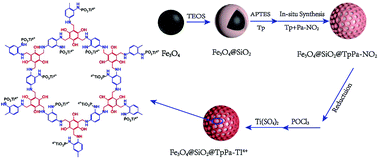Core–shell magnetic microporous covalent organic framework with functionalized Ti(iv) for selective enrichment of phosphopeptides†
Abstract
Selective, sensitive and efficient phosphopeptide enrichment is significant in understanding phosphorylation-regulated processes and finding potential biomarkers. Magnetic materials have significant advantages for the separation and enrichment of modified peptides and proteins. In this work, we fabricated a core–shell magnetic Ti4+-functionalized covalent organic framework composite (denoted as Fe3O4@SiO2@TpPa-Ti4+) to selectively capture phosphopeptides in biosamples. The specific porous structure makes high surface area, which provides space and more affinity sites to binding titanium ions. The loading capacity of titanium ions was as high as 14% (wt%). Calculated by the MS results of α-casein tryptic digests, the binding capability could reach 200 mg g−1. Fe3O4@SiO2@TpPa-Ti4+ nanoparticles also demonstrate high sensitivity (above 0.2 fmol μL−1) and selectivity (α-casein : BSA = 1 : 5000). 1083 phosphopeptides were identified within two LC-MS/MS replicates with 91.8% specificity (phosphopeptides/all identified peptides). These MS results demonstrate that with the aid of the magnet, this method based on the magnetic titanium-functionalized covalent organic framework composite is applicable to achieve rapid, selective and efficient phosphopeptide analysis.



 Please wait while we load your content...
Please wait while we load your content...